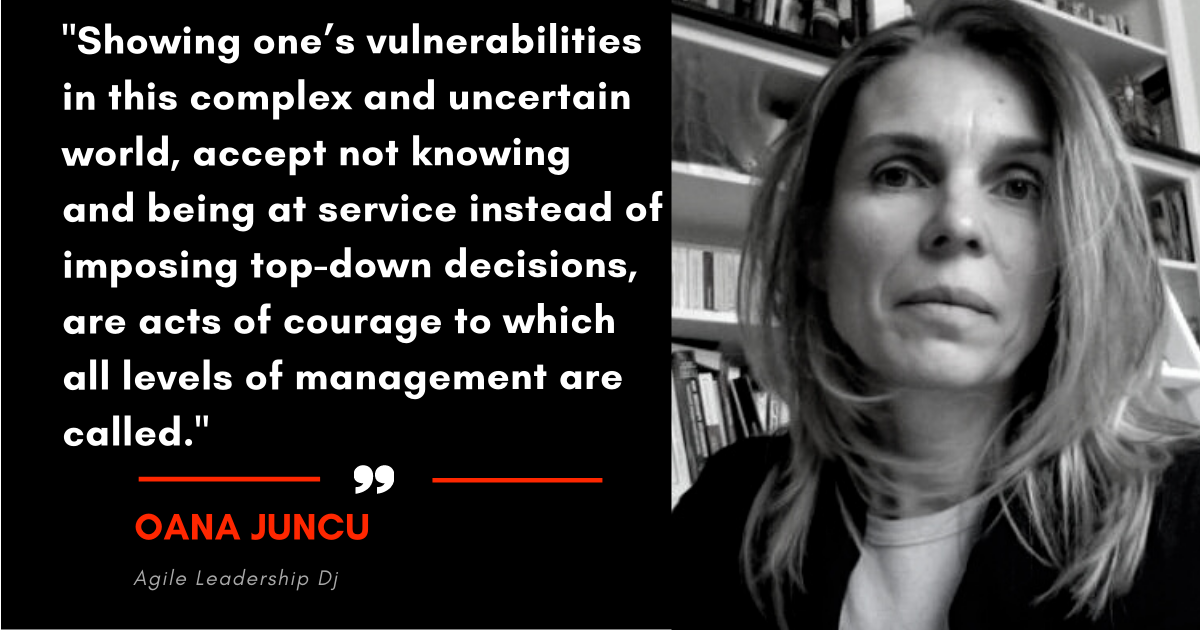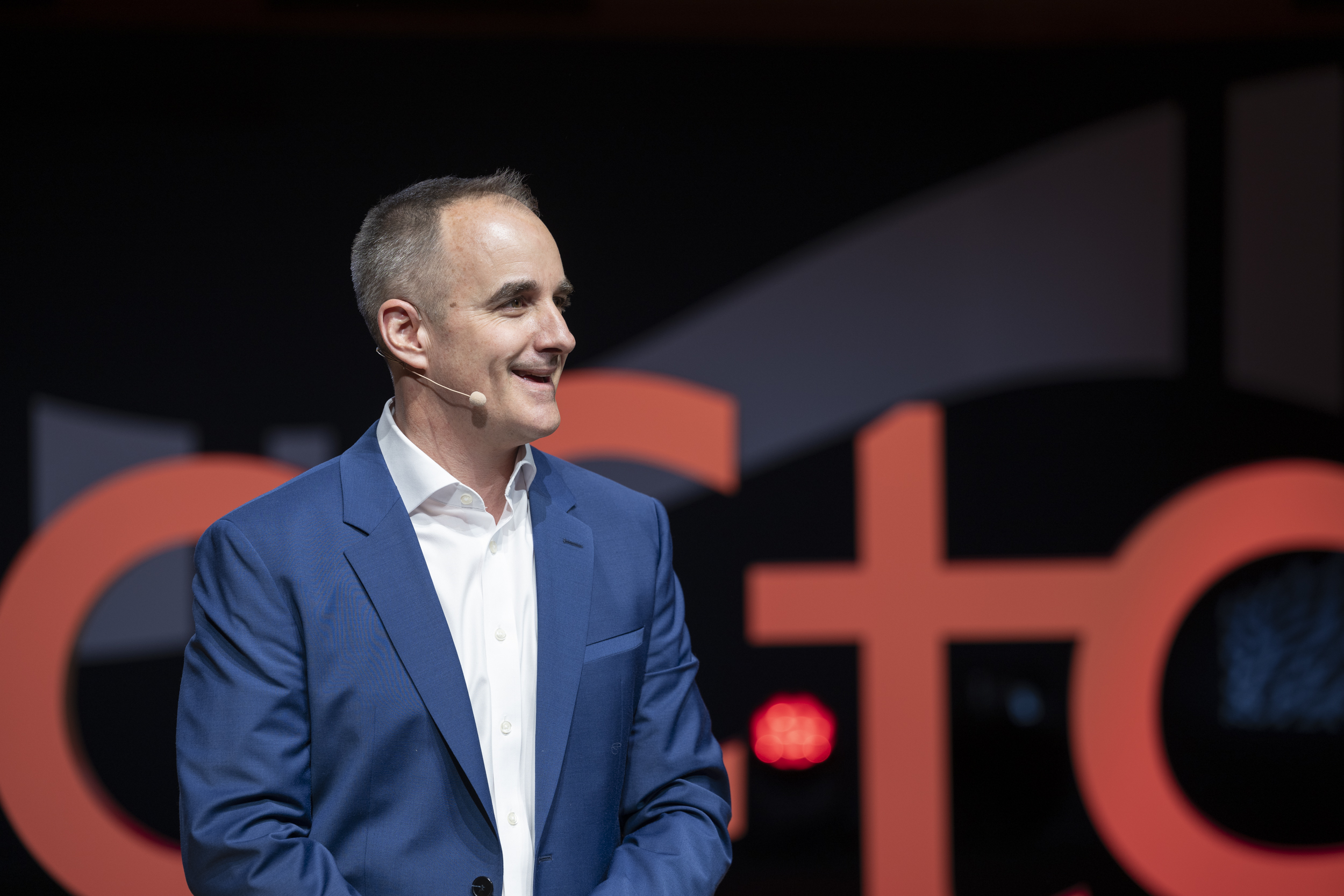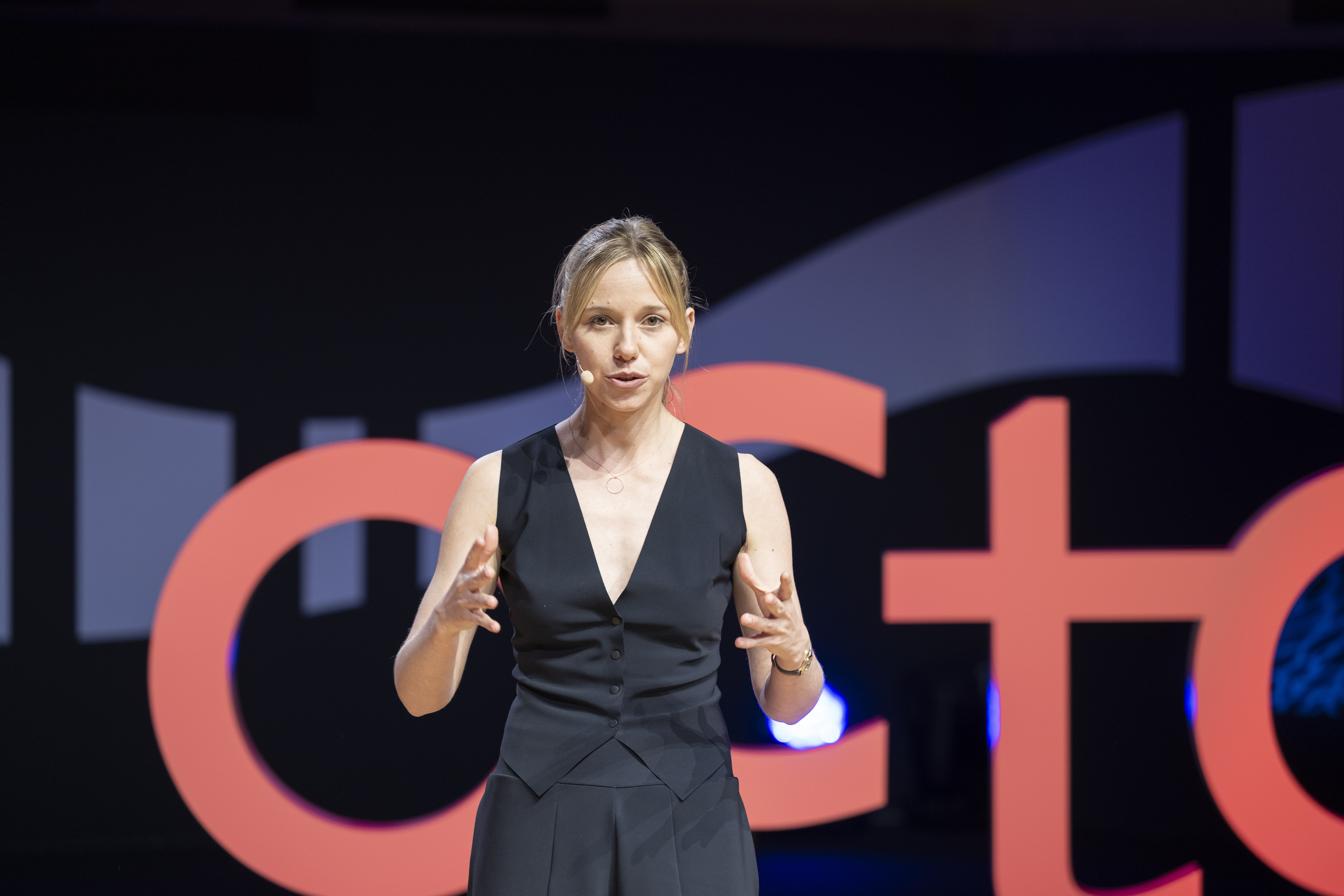Agility for Reinventing Management with Oana Juncu
Agility for
Reinventing Management
Oana Juncu for the Octave webmagazine
The Agile Manifesto and the Agile Manager
A group dynamics is build on two pillars: “achieving together” and “being together”. The “achieving together” part holds the meaning of our common contribution and is crystallised by a shared outcome, that is recognised as useful by clients and all other stakeholders. The “Being together” is built on the quality of interactions between people, and by the place that everyone holds within the groupe. In today’s economic ecosystem, enterprises are still driven by the strong culture of the 20th century that defines prosperity by productivity. This paradigm motivates organisations, and the related management behaviours, to focus and reward capacity of delivery in priority. The ecological and social challenges enterprises face today, make them increasingly aware of the collateral effects of the unique focus on productivity; a world that is exclusively at service of “producing” exhaust ressources and ends by creating waste. The importance of well-being in the workplace is recognised today as a powerful way to step out of the exhaussement caused by the “productivism” culture. 20 years ago, Agile was introduced as a set of principles that underline the importance of balance between the capability to build products and the quality of people dynamics.
Among the 12 principles of the Agile Manifesto, I quote here three key ones;
– Interactions between people rather than applying a process
– Collaboration with the client rather than negotiate a contract
– Adapt to change, rather that following a plan
While the Agile Manifesto was initially defined for Software product development, it is recognised now as widely meaningful for all domains. By following the principles of the Agile Manifesto, the mission of the Agile leader is to re-build and hold the balance between “being together” and “achieving together”, to nourish both pillars by the example of her own behaviour.
Agility with Intention…
When a group commits to a shared purpose, then it can self-organise to reach it. Clearer the goal is, higher will be the capacity of the group to self-organise. The Agile way of “achieving together ” is built on this principle. In a Volatile, Uncertain, Complex and Ambiguous (VUCA) world, a shared vision is the grounding 2root a team relies on, while it can evolve and adapt. We often refer to transformation programs, but in reality, life is essentially in continuous transformation, as there is no life without change. Entreprises, are also living organisms that change continuously in response to their surrounding reality. It’s not really accurate to say that companies need to “learn to adapt” in the current economic ecosystem. They already adapt themselves by default. Enterprises, just as living organisms, react to reality given their skills, knowledge and habits. The way they act and adapt in front of the changing reality is driven by the the enterprise culture, that is a collection of beliefs and shared behaviours. Unlike the “adapt by default way”, adapt with intention is driven by a choice made with awareness of the impact we want to see. To step out from the “adaptation by default” and succeed the Agile transformation we want to see , the Agile Manager holds the responsibility of the intention of that transformation. Every intention is made concrete by the teams achievements impacts on their stakeholders: clients, partners, pairs, etc. The shared vision is co-created by the Agile managers and their teams. If the project changes, the shared purpose is the grounding element of the group. When people define actions that lead to impact, rather than execute actions distributed by an external authority, they become naturally responsible. For the Agile Leader, being at service of the co-creation of purpose is the most powerful way to empower their teams. Both user-centric and frugal approaches like Design Thinking, Jugaad, Lean Start-up 3will be effective ways of “achieving together”, only if the impact of decisions is highlighted by answering a set of questions like : How do our decisions support our shared purpose and the impact we want to see? How will our actions contribute to improve the life of our stakeholders? By asking these questions, the Agile manager embraces a coaching attitude and empowers the “Agility with Intention”, by supporting the “achieving together” pillar of Agile teams.
… and trust driven collaboration
Building something together in continuous changing world, requires us to embrace an experimenting mindset. By it’s very definition, the goal of an experiment is learning, not guaranteeing a pre-defined result. If accept to fail is part of experimenting definition, our success oriented entreprise cultures have hard times to embrace a positive attitude toward failure. All our education is built on rewarding successes and punishing failures. To transform “welcoming failure” from a wishful thinking expression to a true learning mindset, Agile Manager’s challenge is to create a trust based space for “being together”. Here are two of my favorite practices I find very useful, to shift perspective on failure: 1. Don’t call it “failure”! Instead, name it “result of our experiment”. Wether we evaluate it as a success or a failure, it is still just a result. The difference lies more in our judgment rather that in that result’s reality. 2. Shift our evaluation mindset from judgment to curiosity. The invitation to curiosity that is launched by the Agile Manager, opens the field of new possibilities by exploring questions as: What and who might be positively impacted by the result of this experiment … that we formerly called” failure”? What are the learnings? Who does benefit form these learnings? What and who is negatively impacted by the results of our experiment? Open exploration often reveals that what we call failure is mainly our projection of deceived expectations rather than an outcome with a clear negative impact. The Agile Leader, like a facilitator of group dynamics, sets the stage for the quality of interactions between 4team members, and her engagement is to hold a space where all voices are heard with open mind and open will. We build trust is built when we give it, not when we ask for it. Giving one’s trust is an intentional brave choice, so leaders need to be supported themselves on the path toward the Agile mindset, by their own hierarchy. If managers are called to create a trust space where teams can safely experiment, they should benefit also of a safe space; their own managers are also involved to create a failure-tolerant culture and contribute to the “being together” pilar of Agility. Agile mindset needs be adopted at all levels of leadership of the enterprise.
The Courage Of The Agile Leader
The Agile manager is at service of “achieving together” while she builds the Agile dynamics of “being together”. Otto Scharmer says, “A system cannot change if it is not aware of itself”. Enterprises, organisations, 5teams, and individuals, as living systems. The manager’s most important step into the journey toward Agile leadership is to acknowledge with tolerance, own’s difficulties to let go of control and top-down management. Demonstrating good will starts with having good will toward oneself. The capacity to show-up vulnerableis an act of exemplary trust and 6 a condition to build a space of trust, a quality great leaders have. Lead by trust rather than by control, gather teams around a shared purpose, rather than state the strategy to follow, the mission of the Agile manager is anything but easy. Even though we recognise that Agility helps enterprises operate in the VUCA (volatile, uncertain, complex and ambiguous) world, we have hard times to accept uncertainty. This is absolutely normal, our brain is programmed to avoid dangers, and uncertainty is often perceived as a threat for our security. Showing one’s vulnerabilities in this complex and uncertain world, accept not knowing and being at service instead of imposing top-down decisions, are acts of courage to which all levels of management are called. The courage to adopt Agile and accept that uncertainty is the only certainty, is a required mindset for all levels of leadership.
[i] https://agilemanifesto.org/iso/fr/manifesto.html
[ii] https://www.forbes.fr/management/environnement-complexe-manager-son-organisation-en-mode-vuca/
[iii] https://www.huffingtonpost.fr/navi-radjou/innovation-jugaad_b_5197010.html
[iv] https://www.presencing.org/resource/tools/listen-desc
[v] https://medium.com/disruptive-design/tools-for-systems-thinkers-the-6-fundamental-concepts-of-systems-thinking-379cdac3dc6a
[vi] “BrenéeBrown, “Dare To Lead”, p. 34
 Oana Juncu likes to call herself an “Agile Leadership DJ”, who mixes all practices that help
Oana Juncu likes to call herself an “Agile Leadership DJ”, who mixes all practices that help
individuals, teams and organisations to become proud of their outcomes. She is the founder of
her coaching company, Coemerge, that supports companies on their Agile transformation journey,
facilitating systemic change in groups dynamics. She is a member of the education core team
delivering the Collective Intelligence Curriculum at CY University, where she is in charge of Agile
and Design Thinking domains.
Share this Post








